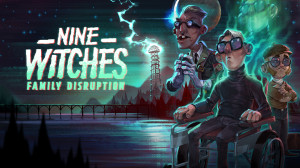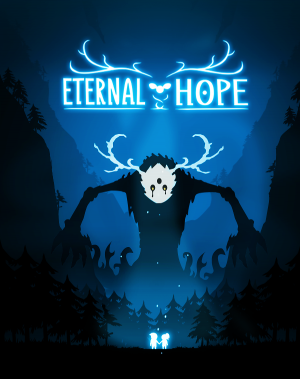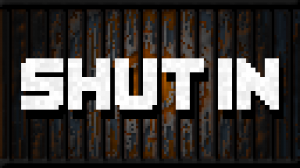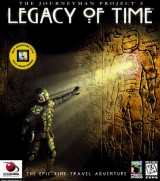Review for Nine Witches: Family Disruption

Nazis and the occult will forever be inseparable, though rarely in a way that turns out well for them. The videogame industry has proven that the only thing more appealing than beating Nazis is watching them turn into zombies first, and then beating them. Indie developer Indiesruption clearly understands this, and the proof is in Nine Witches: Family Disruption, a supernatural alternate-history WWII adventure game with great retro-style presentation, lots of charm, and perhaps a little too much meta (and toilet) humour. Though experienced gamers may find its puzzles a tad easy, and not everyone will appreciate the addition of combat, Nine Witches is sure to provide some real laughs along the way with its zany plot and characters.
You play as both Alexei Krakovitz, a wheelchair-bound professor with paranormal abilities, and his Japanese assistant Akiro. Due to the professor’s expertise in the supernatural, he’s been chosen by Norway’s Prime Minister to investigate a secret occult branch of the Nazi military after they let loose an ancient curse that plunges the town of Sundӓe into darkness. You’ll spend most of your time as Akiro doing physical tasks such as solving puzzles and shooting Nazis, though you can switch to the quadriplegic Professor Krakovitz at any time. He can’t use his arms or legs but is able to converse with spirits, and eventually even bend certain malleable minds to his will.
The enemy is the Okkulte-55, a secret division of the Third Reich. They have set a plan in motion that they hope will win them the war, but at a terrible cost for humanity. Their antics have caused a dark moon to appear, and the denizens of Sundӓe have not seen daylight for some time. Krakovitz and Akiro go undercover as a German movie director (with haemorrhoids) and his assistant, respectively, to infiltrate the town and attend a very exclusive party being held by Nazi officers, all in order to thwart their plans. The relationship between the professor and Akiro comes across as a purely professional one, but you do get a sense that they know each other very well and can work together effortlessly, which becomes almost touching in its own way. Sundӓe is rife with colourful characters including townspeople, resistance members, Nazis, farmers, members of the church, witches, recently deceased spirits … the usual fare for a Norwegian town as far as I understand.
The humour is generally on point, and I even found myself laughing out loud on a couple of occasions, though a lot of the farting and bowel-based gags didn’t really land for me. Running gags are prevalent throughout, such as a clown with awful puns whom the in-game characters seem to find hilarious, and there’s a strange giggle that begins to spread between the townspeople, almost like a disease. Meta jokes are often used as well, at one point going all in on the fourth wall breaking. While all this works most of the time comedically, it can also detract from the immersion the game otherwise does so well to create. A little humour to relieve tension is always welcome, but some over-the-top elements feel at odds with the game’s more serious themes.
The story itself is told in distinct segments, but in true LucasArts fashion, sometimes you’ll be treated to a “meanwhile” transition, where the game cuts away to a scene of the villains offering more exposition on what is happening from their end. You’ll soon find that Sundӓe is a town full of mysteries that you need to get to the bottom of. While Akiro and Krakovitz try to secure entry to the party the real movie director was invited to (before he was rudely ambushed, stripped, and left at the side of the road), they will encounter quirky new mysteries to solve: Who is the vigilante mime? And what is up with the strange small man who owns the three-testicled-salmon truck? These questions, and more, will be answered as the two heroes investigate and ultimately attempt to sabotage Nazi operations.
Certain events may cause changes in Sundӓe, which means you will have to revisit places you thought you were finished with. Characters may have moved to a different location or something new might have been unlocked or opened that wasn’t before. This helps give the narrative a sense of cause-and-effect, and also makes the town feel more dynamic. It has its downsides, though, as there were a couple points when I had to backtrack somewhere but was given no indication that I should do so, or that anything had changed in that specific area. As the plot progresses, it gets wilder and more chaotic, though the pace of the gameplay slows down when you have unlocked all areas and have a wider range of places to revisit.
Nine Witches is presented in third person, with the protagonists moving around some very detailed pixel art backgrounds. Whichever character is selected will be followed around by the other. The game recommends using a controller to do so, and I agree. The keyboard works well enough, but the controller uses vibrational feedback to good effect. Left stick or WASD moves the character, and face buttons or arrow keys are used to look, speak, and perform any other miscellaneous interactions. Hotspots are indicated by text labels and an arrow pointing to them once you get close enough. To move between locations, a map screen shows a zoomed-out view of the region on which tiny versions of your characters run around to get to their next destination. Sometimes areas are blocked off by Nazi soldiers until you trigger a story event that will make them available.
There are plenty of townspeople and Nazis mulling about, all of whom you can talk to but not all are important. Generally any NPC that isn’t relevant to the story will politely compliment your dapper outfits and move on, even the Nazis. In between conversations you’ll pick up needed items and examine them in inventory, which is sometimes required to discover a new function. Gameplay generally consists of finding the correct item to use on another object, person, or thing in the environment. This is never done very creatively, though, as usually it’s an everyday object without much mystery about where it’s meant to be used. You have access to a notebook which contains all of your current objectives, and you can manually save the game whenever you want, though there is also an autosave feature.
Akiro’s practical skills are not always enough to solve a puzzle, so sometimes you will need to use Krakovitz’s supernatural powers. You do this by switching to him and then activating his astral projection ability, which causes his soul to leave his body and let you float around independently of it. In this state, you can pass through closed doors and speak to spirits of the recently deceased. This allows Krakovitz to obtain helpful information that he can pass back to Akiro. Later in the game, you will gain the ability to bend the minds of certain weak-willed characters, indicated by symbols above their heads. Once you take mental control of a victim, you can float to a certain spot and order them to “come here,” or you can move to a hotspot and say, for example, “unlock this door.” You’ll only do this a few times, however. In fact, these paranormal gifts in general don’t get as much attention as they should.
There were a couple of puzzles that had me completely stumped, but these usually boiled down to having to revisit an area I thought I was done with, or studying the environment more closely. If you are struggling to find hotspots, which I never did apart from one specific puzzle, the professor has an additional ability in his spirit form that sends out a sonar wave to detect interactive objects. It’s a pain to use, however, especially when playing as Akiro, because you have to go through the process of switching to the professor, activating his spirit state, and then floating around the screen, pinging several times as its range is not very large.
There are also a couple of classic maze puzzles where you continually walk into one entrance and out another random one until you find the correct sequence. This is a pretty tired genre trope and I could have done without any more in my lifetime. As for the game’s overall challenge, I managed to get through it without a walkthrough, which by my own criteria for measuring difficulty in adventure games means it will probably be on the easy side for most experienced adventure gamers.
There isn’t much variety in the way you solve puzzles, but this is balanced out with scripted events in which enemies (Nazis and eventually zombies) are thrown at you. Akiro has his own Japanese pistol, and during these action sequences you can run around the screen, dodge roll to avoid bullets, and fire back at your opponents. There are alternate weapons scattered around that can do more damage, giving you more incentive to put yourself in potential danger to try and grab them, but these have finite ammo and you will eventually find yourself having to swap back to the faulty pistol as a last resort. Unfortunately, Akiro’s pistol jams sometimes, leaving him stationary and vulnerable for just a second before he can get moving again.
All characters have health bars over their heads to indicate how many more hits they can take. Professor Krakovitz has no way to defend himself, which means that you will have to keep him in mind during battle and make sure you draw enemies away before they’re able to attack him. If either of you dies, it’s game-over, but fortunately you will only have to restart from the beginning of the encounter. For adventure game purists, there is an option to lower the difficulty of these action sequences, which is helpful as they do get fairly difficult towards the end of the game. Also, I think I speak for many gamers when I say that having to look out for a defenceless character is always a pain, and this game is no exception.
Visually the game features wonderfully stylised pixel art, with a gloomy colour palette to set the appropriately ominous tone. There is also a black-and-white option in the settings if you prefer. You will speak with all kinds of people in your travels, such as an insane nun, a suicidal farmer, and a resistance liaison with a gambling problem. All of their designs reinforce their personalities, and there are some nicely emotive speech animations unique to each character as well. Akiro has a delightfully jaunty walk cycle, though Krakovitz just sits still as the wheels on his chair spin inexplicably. Outdoor scenes are inhabited by tiny creatures like birds, rats, and worms, which are all moving around doing their own thing, which makes each screen feel alive.
The audio design reinforces the eerie ambiance, with the sound of grasshoppers, birds, and rain helping contribute to the atmosphere. But sound effects are also used expertly to comedic effect, accompanying the oft-amusing writing and animations. My favourite was the little giggling sound people make when they laugh, which, to my delight, is used often. The combination of baby-like crying and the thrashing about when someone is particularly upset also amused me every time. The score, consisting of synthesized orchestral instruments, is reminiscent of old noir movies, perfectly emulating classic tales of espionage and horror. My only gripe would be that some music begins to get repetitive and certain effects such as sirens can be a little grating. There is no voice acting, but little midi blips represent speech to accompany the subtitles.
Overall, the presentation of Nine Witches: Family Disruption consistently shines throughout. Its retro aesthetic is charming to look at and is complemented by an excellent soundtrack and clever, often amusing writing. It certainly doesn’t overstay its welcome with its four to six-hour runtime, though its puzzle variety leaves something to be desired and its paranormal elements feel underused. The action sequences might be tiresome for some, but serve nicely to inject a change of pace once in a while. The story takes some interesting twists and turns, but the potential zombification of the entire world at the hands of the Nazis is always at the forefront. Immersion may have been sacrificed for humour in some places, but Nine Witches is nevertheless an easy recommendation for adventure gamers that enjoy storytelling over challenging gameplay.
Our Verdict:
Though its puzzles are simplistic, Nine Witches: Family Disruption is both an audio-visual retro treat and an amusing supernatural WWII romp that is bound to be a winner for those who can handle a little combat in their adventures.



_capsule_fog__medium.png)
























